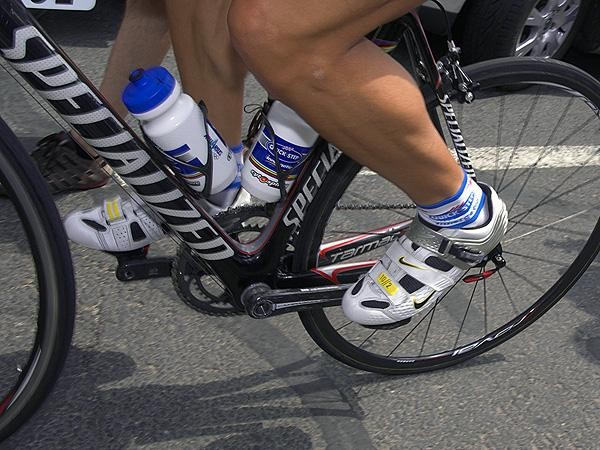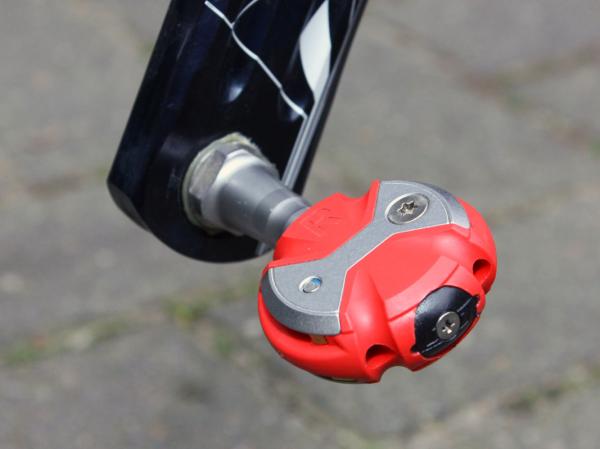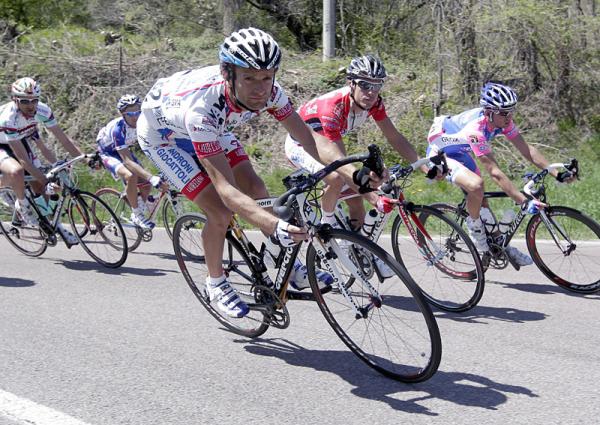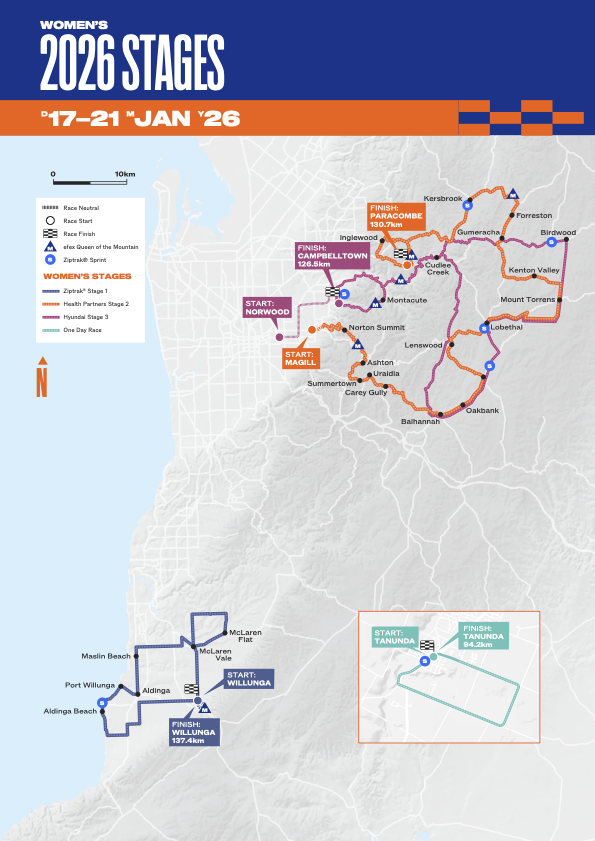Cyclingnews Fitness Q&A - July 7, 2010
Your fitness questions answered



Got a question for the fitness panel? Send it to fitness@cyclingnews.com. Emails may be edited for length or clarity, but we try to publish both questions and answers in their entirety.
Using pedal spacers
I've read that everybody is designed asymetrically and this is normal and that a fit guy in California uses pedal spacers on the lef side only and that this is normal too.
Someone else said that 30 or 40 percent of people need a pedal spacer on the left side or maybe it was both sides because pedals don't have long enough axles. I have asked advice here before and it has worked and I'm curious if I should use a pedal spacer?
Should I use one on the left side or both sides if I need to use one?
Wilson
Scott Saifer says:
Wilson,
The latest race content, interviews, features, reviews and expert buying guides, direct to your inbox!
Steve may have a more detailed answer for you, but I'd guess anyone who says that 30-40 percent of riders need a pedal axle spacer is selling pedal axle spacers, or using a very strange definition of need.
I'd say a rider needs a particular tweak if it will make them more comfortable, increase the power they can sustain for some amount of time, or help them avoid injuries. With that definition of need, not many riders need pedal axle spacers.
There are two reasons I can think of to use pedal-axle spacers. One is to get a larger Q-factor or horizontal pedal spacing. A small percentage of riders benefit from that and the spacers would be used symmetrically. I've had a few riders in for fittings who either have very large medial maleoli (the inside ankle bone that sticks out towards the crank) or who pedal most comfortably with their toes turned out.
Sometimes that is more pronounced on one side than the other, and I might install a pedal spacer on one side to keep the rider from rubbing their ankles too hard against the cranks.
You might be getting mixed up with cleat shims and wedges rather than axle spacers. Do not doubt that more than a quarter of riders would benefit from appropriately chosen shims and/or wedges, and the number might be 40 percent or even more.
Steve Hogg says:
Wilson,
First, I agree with Scott regarding the definition of need. Second, let's take what you've said one thing at a time:
1. "...designed asymmetrically" I wouldn't use the word designed but that depends on your beliefs I suppose. I would use the word 'formed'.
We are all asymmetric at the most basic level. Look at our organ layout: the left lung has two lobes, the right lung has three; the stomach is on the left, the liver is on the right; the left kidney sits higher than the right kidney etc. etc.
There are neural connections from the spine to these organs and stimuli runs both ways. Each side of brain specialises to varying degrees and so on. Externally, there is a veneer of symmetry but handedness, footedness and accidents of birth or development all conspire to make us functionally asymmetrical. So yes, I agree.
2. "...a fit guy in California uses pedal spacers on the left side only and that this is normal too". I assume that by 'pedal spacers' you mean KneeSavers which are pedal spacers available in 20, 25 and 30mm lengths. If so, I struggle with this one.
I don't doubt what you are saying but it seems to me that it is likely that he either has a strange clientele or that he is treating symptoms rather than problems. It is true to say that I see more people who have a left knee that tracks further out from the top tube than the right than I see the converse.
The great majority of the time, this is the result of a right side issue and the patterns of compensation that arise tend to cause the left knee to sit further out. This is by no means universal but it is common. Resolving the right side issue solves or moderates the left side knee tracking problem in most cases.
Maybe this gent is seeing the same things as I am but not resolving the right side issue that is the underlying cause in many cases, but is instead, spacing out the left pedal. Hard to say on the info you have provided but that would be my best guess.
If I am wrong in the assumption I've made about KneeSavers, then he might mean a pedal spacing washer which is a 2 or 3 mm washer that can be inserted between pedal axle and crank arm on aluminium cranks. I'm guessing that you mean KneeSavers because of the prevalence of carbon cranks means that the 30 - 40% of his customers you mention can't all have aluminium cranks.
3. "...that 30 - 40 percent of people need a pedal spacer... because pedals don't have long enough axles."
Again, I struggle with this. I get a large number of fit customers who have done the rounds and ended up with me. What I'm saying is that I see what I suspect is a skewed sample who are probably functionally worse than average. Even so, I use a pedal spacer, spacers or longer than standard pedal axle(s) from 4 - 10 percent of the time.
There are some people who are just so dysfunctional in the hips and lower back that they need their pedals to be spaced out so that their knees descend over their feet rather than outboard of the feet, but there are a larger number who have one knee which tracks further out than the other. In many of these cases this can be remedied without resorting to pedal spacers or longer axles.
4. "Should I use one of them on the left side or both sides if I need to use one?"
I remember some of your previous queries to the panel and if memory serves, you haven't mentioned anything that would suggest you need your pedals spaced out. Do you have a problem at the moment that is giving you trouble or is this query because you read something you hadn't considered before?
Fear of descending
I have been cycling for about 12 years now, and what started as a 'small' fear has in the last six years turned into something terrible (to the point that I calculate the amount of descending instead of ascending in any bike race I sign up for).
I have been pretty good at using my heart rate monitor these last two years and have found that on training rides, while my climbing speed has increased and my heart rate has decreased, when it comes to going down the other side of the hill my heart rate increases (recently I hit my max heart rate of 212bpm on a descent) and my speed dwindles. I lose a lot of time, energy and race position on my descents.
Have you any recommendations as to how to work on overcoming this fear? Most people seem to think that riding down a hill is fun and I go a bit quiet because I don't feel they would understand. I am really struggling with it and still get on my bike even if I am so scared my elbows, shoulders and fingers lock up for part of the ride. I live in a mountainous area too, so it is impossible to avoid having to ride downhill.
Alex
Carrie Cheadle says:
Alex,
You are in a vicious cycle of fear that ends up continuing to feed into itself. The good news is that this is something that you can work on and overcome. It will take some time and very deliberate effort on your part, but if your fear is to the point where it takes away your enjoyment AND impacts your end result, it is worth the doing the work.
1. Work on your bike handling skills: Even though you've been riding for 12 years and are probably an expert in other areas of racing, your fear has kept you feeling like a newbie when it comes to the descents. The more confident you are in your ability, the more relaxed you will be on the bike.
You're probably thinking right now - 'I know the skills, I know how to do it and what I'm supposed to do.' Go do it anyway. Go find a descending clinic and take the time to work on that skill. You'll be surprised at the impact it has on your confidence.
2. Relax your mind: Your anxiety about descents is starting to build even before you get on the bike. Now when it comes to the descent - fear is your automatic default setting. It's just like printing out a document on your printer. When you hit 'print' the document prints using the default settings. If you want to change the settings, you have to go in and deliberately change them - you can't just keep printing the document over and over hoping it will change to the setting you want.
After six years of this fear building up, it is going to take some time to create a new default setting. You can start changing this by choosing what you want to say to yourself ahead of time.
There are two different tactics to try here. One is to repeat a mantra over and over on the approach and during the descent to help your mind relax. 'I am a strong confident cyclist' or 'I am relaxed and controlled on descents'. You want to start giving yourself the message of what you want versus what you don't want. Another way to shift your focus is to focus on your breathing and focus on good technique. Help keep your mind occupied with processing perfect technique instead of processing your fear.
3. Relax your body: Chances are, as you are descending you are holding your breath. Holding your breath or shallow breathing leads to muscle tension which compromises your balance and coordination on the bike which feeds right back into that cycle of fear.
You're worried about the descent, you're tense on the bike which makes you feel sketchy on the descent, which your brain picks up on immediately and says 'SEE! Do you see how scary and dangerous this is?' and that message gets carried forward onto the next descent and continues the cycle. And in your case, you've experienced that tension to the point that your joints are locking up.
Whenever you start feeling nervous about descending - breathe. Try and make your exhale a little longer than your inhale and that will help slow your breathing down and help you to relax. The next piece is to relax your muscles. Start by reminding yourself to relax your hands and face. You can set an alarm to beep every couple minutes to help you remember to relax.
Go pick out a descent that is just a little nerve-wracking and practice these things there until you feel confident on that descent and then move onto another descent that produces a little more nerves and practice there. The more you practice these things the better you will get at being able to use them.
With over six years of triggering that stress response, you might need some extra tools and support to help you work through this. It is definitely something you can work on and doesn't have to hold you back from performing to your potential. If you find that you are still struggling, seek out the professional services of a Mental Skills Coach or Sport Psychologist and they'll have you flying downs descents and taking control of your performance.
Training after blood donation
Hi,
Being a 40-year-old two-time cancer survivor, and recipient of blood transfusions as a result, I give blood every chance I get, which turns out to be every eight weeks. I'll shift a donation a little bit for a race, but try to keep to about six donations a year.
I have three questions. First, do you know of data to support the idea that the body will supercompensate, and raise the red blood cell count to a higher level? Second, what is the best way to train in the weeks immediately following the donation? Finally, what is the time to be at 90 percent of my pre-donation red blood cell count?
Thanks,
Geoffrey
Scott Saifer says:
Geoffrey,
Congratulations on beating cancer and it's awesome that you are "giving back" the gift of life. The research says that you're "back to normal" in terms of red cell count about three weeks after a donation. What it doesn't look it is the effects on fitness of being below normal for three weeks. During those weeks you are anaemic and your training is not as effective as it would be if you were at full-hematocrit.
When you give blood, your body will respond to your decreased oxygen carrying capacity with a spike of EPO. About two weeks later, the first new red cells produced in response to that spike will enter your blood stream. By three weeks, enough new cells have been produced to replace the ones removed. There is no reported supercompensation to above normal hematocrit.
Immediately after a donation it is recommended that you avoid strenuous activity for 24 hours. In the few weeks following a donation, you are anaemic, meaning that your maximal aerobic power is reduced and aerobic training will not be effective. That suggests dedicating post-donation training to skills and anaerobic efforts.
One has to recover from extended anaerobic efforts however, and reduced hematocrit blocks that recovery, so that leaves skills and short anaerobic efforts (sprints, jumps, spin-ups). I'd suggest doing low-intensity but long recovery rides a few days per week, and then less than 30-second, very high intensity stuff one or two days per week.
Geoffrey then responded:
Thanks for the quick response!
How is giving blood different from going up to altitude training for a couple of weeks, in terms of aerobic improvements, and any other effects that you think are relevant?
Scott Saifer says:
Geoffrey,
Making a blood donation and going to altitude both cause an increase in circulating EPO and thus the production of new red cells a few weeks later, but when you go to altitude the new red cells are dumped on top of a "normal" load.
When you make a blood donation, they are filling the gap left by the donation. I've had a few female clients with abnormally heavy menstrual flow. That's not too different from your donation of blood every eight weeks. They end up anaemic and with drastically decreased aerobic power.
Foot hot spots
Recently, I switched to Speedplay pedals to see what all the hype was about. I like the feel, and it seems to have eliminated my dead spot at the top and bottom of my right pedal stroke. With that being said, I have moved the cleat more closer to the middle of my foot, as I am 6'3" and need to take advantage of the mechanical levers that are my lower limbs.
The position feels fine, but I now experience some hot spots on my feet during longer rides. After those long rides, I usually wake up with a sore heel on my left foot, akin to plantar fasciitis pain, but it subsides after a few early morning steps.
Even worse, the left side of my lower back periodically experiences muscular tightness, requiring me to stretch in the saddle. It's tolerable on solo rides, but tough to manage on faster-paced group rides and training races.
My current setup leaves me feeling a bit too "upright" when riding on the tops of the bars and in the hoods, but my drop position feels perfect. Any suggestions, other than a "pro fitting?" I was thinking about trying the new DMT Speedplay-specific shoes to see if that alleviates the foot issue, as well as utilising a carbon sole for stiffness during cycling and less flex in the arch/fascia on my left foot.
Dan,
Rochester, MN
Steve Hogg says:
Dan,
Speedplays, even with the adaptor plate, are a lower than average profile in terms of height from pedal axle centre to base of shoe. What pedal system were you using before? The answer to that will let me advise you on how much you should have dropped your seat.
Additionally, when you say: "I have moved my cleats closer to the middle of my foot" do you mean laterally, that is that you have moved your cleats across the shoe or further to the rear.
If you have moved the cleats across the shoe further towards the middle, (and that is my assumption so please correct me if I am wrong) that will bring your feet closer to the crank arms. If you have moved the cleats rearward that will cause you to not only extend your legs more but to reduce ankle movement to varying extents. The sum total of that means that you would need to lower your seat height.
The sum total of what you say - that is, hot spots plus left-sided back pain - almost certainly mean that your seat is too high.
Any challenge to a position causes the rider to develop a pattern of compensation. A challenge can be many things; seat too high, cleat rotational position fixed at the wrong angle on one or both feet, a leg length difference or L/R difference in pattern of flexibility, etc. The problem is that all the patterns of compensation which we automatically develop to cope with a challenge to position on a bike all increase our tendency to asymmetry.
What I am guessing is that with the new pedals and cleat position you are now sitting too high and that the extra effort needed to reach the bottom of the pedal stroke is the source of your hot spots or has been enough to push you over the edge because of poor foot cant on the pedal. If the seat is even a few mm too high, most riders will start to drop their right hip at some level. This usually causes pain on the left side of the lower back as a result, though this is not universal.
I'd suggest dropping your seat 5mm and reassessing the severity of the symptoms. Let me know what happens.
Dan then responded:
Steve,
I have often thought that I have some asymmetry in my lower limbs, or even some flexibility/inflexibility issues, which could be the source of the left LBP. Could it be possible that, if my left leg is slightly shorter than the right, over time, my saddle would develop a lateral tilt favoring the longer, or more powerful, side?
I think I might go to a physio and have them do a "once over," with regards to limb length and hip flexibility. Let me know if 5mm is still your recommendation for dropping the saddle. I really appreciate your insight!
Dan.
Steve Hogg says:
If your cleats are now further rearward than with the Ultegras, then you are extending your legs more which again means seat height may be the issue.
If your seat is pushed down on the left side, then you are reaching further with the left leg than the right. This may be caused by a shorter leg, a tighter left side or a seat that is too high which forces you to compensate. If the latter, most riders will favour the right side at the cost of the left.
The physio consultation won't really be relevant unless they see you on the bike. Knowledge about how the body functions globally is essential but it can only be put into context once how the rider functions under load on a bike is taken into account.
I still recommend dropping your saddle 5mm - this is about the smallest amount that will make a significant difference one way or the other. It may not be a solution but what follows may give me clues to advise further.
The Cyclingnews Form & Fitness panel
Scott Saifer (www.wenzelcoaching.com) is head coach, CEO of Wenzel Coaching.com and has been coaching cyclists professionally for 18 years. He combines a master's degree in Exercise Physiology with experience in 20 years of touring and racing and over 300 road, track and MTB races to deliver training plans and advice that are both rigorously scientific and compatible with the real world of bike racing.
Scott has helped clients to turn pro as well as to win medals at US Masters National and World Championship events. He has worked with hundreds of beginning riders and racers and particularly enjoys working with the special or challenging rider. Scott is co-author of Bike Racing 101 with Kendra Wenzel and his monthly column appears in ROAD Magazine.
Steve Hogg (www.cyclefitcentre.com) has owned and operated Pedal Pushers since 1986, a cycle shop specialising in rider positioning and custom bicycles. In that time he has positioned riders from all cycling disciplines and of all levels of ability with every concievable cycling problem. Clients range from recreational riders and riders with disabilities to World and National champions.
Kelby Bethards, MD received a Bachelor of Science in Electrical Engineering from Iowa State University (1994) before obtaining an M.D. from the University of Iowa College of Medicine in 2000. Has been a racing cyclist 'on and off' for 20 years, and when time allows, he races Cat 3 and 35+.
He is a team physician for two local Ft Collins, CO, teams, and currently works Family Practice in multiple settings: rural, urgent care, inpatient and the like.
Pam Hinton has a bachelor's degree in Molecular Biology and a doctoral degree in Nutritional Sciences, both from the University of Wisconsin-Madison.
She did postdoctoral training at Cornell University and is now an associate professor of Nutrition and Exercise Physiology at the University of Missouri-Columbia where she studies the effects of energy balance on bone health. She has published on the effects of cycling and multi-day stage racing on bone density and turnover.
Pam was an All-American in track while at the UW. She started cycling competitively in 2003 and is a three-time Missouri State Road Champion.
David Fleckenstein, MPT, OCS (www.physiopt.com) is a physical therapist practicing in Eagle, ID and the president of Physiotherapy, PA, an outpatient orthopedic clinic focusing in orthopedics, spine, and sportsmedicine care.
His clients have included World and US champions, Olympic athletes and numerous professional athletes. He received his Masters degree in Physical Therapy from Emory University and is currently completing his doctorate at Regis University.
He is a board certified orthopedic specialist focusing in manual medicine and specific retraining of spine and joint stabilisation musculature. He is a former Cat I road racer and Expert mountain biker.
Carrie Cheadle, MA (www.carriecheadle.com) is a Sports Psychology consultant who has dedicated her career to helping athletes of all ages and abilities perform to their potential. Carrie specialises in working with cyclists, in disciplines ranging from track racing to mountain biking. She holds a bachelors degree in Psychology from Sonoma State University as well as a masters degree in Sport Psychology from John F. Kennedy University.
Dave Palese (www.davepalese.com) is a USA Cycling licensed coach and masters' class road racer with 16 years' race experience. He coaches racers and riders of all abilities from his home in southern Maine, USA, where he lives with his wife Sheryl, daughter Molly, and two cats, Miranda and Mu-Mu.
Dario Fredrick (www.wholeathlete.com) is an exercise physiologist and head coach for Whole Athlete™. He is a former category 1 & semi-pro MTB racer. Dario holds a masters degree in exercise science and a bachelors in sport psychology.

